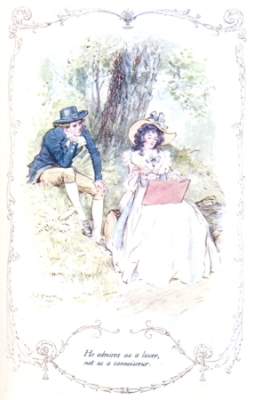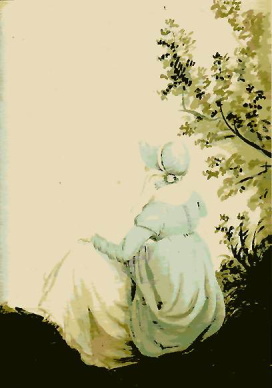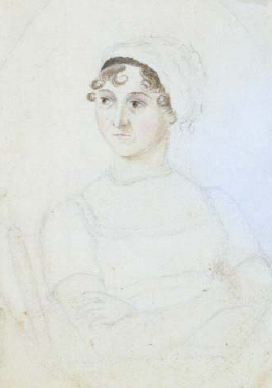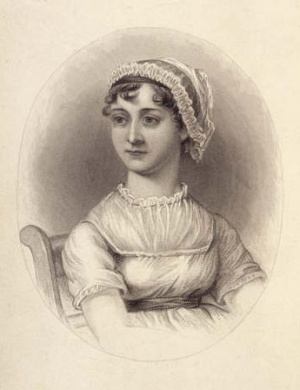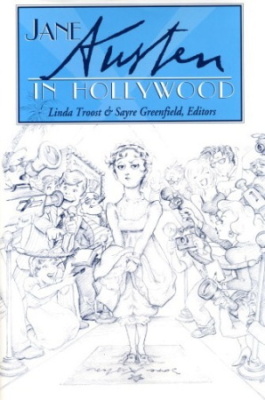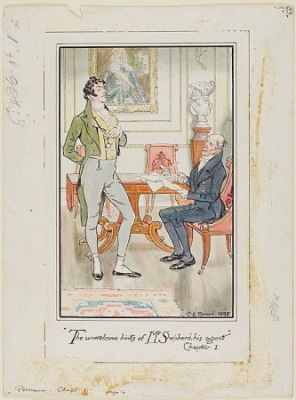|
we all know the scene in Pride and Prejudice in which Elizabeth and Jane Bennet, accompanied by Maria Lucas, having returned to Hertfordshire after their various travels, join Kitty and Lydia Bennet for luncheon at an inn. Lydia shows them a bonnet she has just purchased at a shop across the way. Before anyone else can pass judgment, Lydia herself declares that she herself does not think it pretty and announces that she will entirely make it over when she gets home. Her sisters “abuse[ ] it as ugly,” and Lydia says, “‘Oh! but there were two or three much uglier in the shop; and when I have bought some prettier-coloured satin to trim it with fresh, I think it will be very tolerable’” (219).
This not quite “throwaway” moment gives us, as Austen so often does, insight into a decidedly shallow personality. In modern terms, Lydia is a shop-aholic who cannot walk out of a store without buying something, and who has to give her unnecessary purchase a complete makeover in order to justify buying it in the first place. What Austen does not give us here, however, is a description of the bonnet. One could argue that it matters little what the bonnet actually looks like because the author has made her point; she manages to combine higher ideals (there is a difference between good and bad taste) with a kind of democracy—the reader is free to imagine for him- or herself just how ugly the bonnet is. Even Lydia thinks it not pretty, so the imagination can run wild. It seems almost churlish to deny anyone that pleasure by giving this notorious accessory any specific form.
For a writer not generally known for lavish visual descriptions (“It is not the object of this work to give a description of Derbyshire . . .” [240]), Jane Austen’s writing has been compared to visual art by a surprising number of people—beginning with Austen herself. Her famous statement about the “little bit (two Inches wide) of Ivory” (16 December 1816) is a reference, whether intended modestly or ironically, to miniature painting (usually done in Austen’s day in watercolor on ivory). Austen’s literary style has also been compared to the exquisite finish of fifteenth-century Flemish painting (by Sir Walter Scott) and to the work of the American Precisionists of the early twentieth century (by an anonymous critic in the Sewanee Review in 1913. Comparisons to what is presumed to be the straightforward realism of photography have also been popular, whether approvingly (Austen’s nephew and first biographer James Edward Austen-Leigh) or not (Charlotte Brontë).1
Jane, Cassandra and other artists
Yet Jane Austen was not noted for any actual skills in the visual arts. As we know, a “‘really accomplished’” young woman should be artistic as well as musical, fluent in the modern languages, possess a certain air, etc. (39). Although the famous discussion about the accomplished woman in Pride and Prejudice, as Elizabeth Bennet recognizes, sets up an ideal impossible to live up to, it is also true that certain Austen characters at least make an attempt to be both musical and artistic. Georgiana Darcy somehow manages it, as does, with less pleasing results, Emma Woodhouse. In the case of multiple daughters, however, it seems that one sister would often be pegged as the “musical one,” another as the “artistic one”—this is true of course of the Dashwood sisters, of the pretentious Beaufort sisters in Sanditon, and it was true of the Austen sisters. Jane seems to have been considered the more musical Austen daughter while Cassandra was the artist.
In the novels, Austen can use artistic skill (or lack thereof) as a revealing metaphor. Elinor Dashwood’s talent for capturing likeness on paper is matched by an acute perceptiveness in discerning the motives and personalities of others; Emma Woodhouse’s underdeveloped talents in both areas cause much confusion in the plot. A superficial reading of Sense and Sensibility would identify Elinor’s artistic talent, as mentioned, with her perspicacity, while Marianne’s preference for music and poetry would be emblematic of her self-indulgent emotionalism. Emma, an “imaginist” (335) in the author’s own coinage, can misinterpret what she sees before her. Probably the most irresponsible “visualizer” in Austen’s work, though, is Lydia Bennet, who sees “with the creative eye of fancy” (232) a life of endless flirtation in Brighton before she even gets there.
What we know of Cassandra Austen would not lead us to believe that she was an irresponsible imaginist. This characterization may be reassuring, given that it is to Cassandra Austen that we owe the two most clearly verified portraits of Jane Austen made in her lifetime. One is in a private collection; the other is in the National Portrait Gallery in London. The watercolor, in which Jane Austen, wearing a blue dress, is seen from the back as she sits on the ground, is dated to 1804; her face is completely obscured, as it happens, by a bonnet. The unfinished drawing, in which Jane sits with folded arms, is usually dated c. 1810 or 1811. These two images are reproduced a great deal, yet I feel that the 1804 sketch in particular has not been given its due. What I would like to do in this essay is to begin with these earliest visualizations of Jane Austen by her sister; proceed to some of the ways in which Austen has been visualized subsequently; and relate those to the act of visualizing Austen’s novels, whether by the author herself of by others. Taken together, these visualizations get at a continuing effort to project a meaning or identity onto both Austen and her works as well as an insight into the ways those meanings are defined by individual or cultural predispositions.
Before proceeding, I need to clarify two points: first, although I am aware that referring to Austen as “Jane” is controversial, I do so in the present circumstance in order to distinguish her from Cassandra; and henceforth, for the sake of convenience, I will refer to these portraits as the Bonnet Portrait and the Sketch.
We can begin with the two precious documents, the sketches by Cassandra Austen. We know virtually nothing about Cassandra’s artistic training (presumably at the boarding schools of Mrs. Cawley and “Madame” La Tournelle), or about her exposure to works of art in general. David Nokes states that “Claude Nettes” was hired by Mr. Austen to train both of his daughters in drawing; Cassandra showed considerable flair for this pursuit, Jane much less so (82). “Claude Nettes” is undoubtedly John Claude Nattes, the Anglo-French artist who was a founder-member of the Old Society of Painters in Watercolours in London and is perhaps best known for his images of Bath (Aldred).
We can presume that, like many people in Britain at that time, Cassandra would also have had rare opportunities to view works of art at public exhibitions (we know that Jane did, a subject to which I will return). Cassandra also would have seen family portraits and other works of art at the homes of family and friends, whether in the “original,” as it were, or in the form of copies or engravings. These experiences would have given the Austen sisters some awareness of the works of professional artists, and of the artistic conventions of the time; and, like many an amateur artist both before and after her, Cassandra likely fell back on conventional forms and motifs when approaching her own work.2
Taking likenesses
The general consensus of the time was that the goal of portrait painting was not merely to record a physical likeness of the sitter; the capturing of a character or personality was at least as important (see Shawe-Taylor). Jane Austen’s awareness of this aim is clear from the well-known scene in Pride and Prejudice in which Elizabeth, dancing with Darcy at Netherfield, has been plying him with questions about his relationship with Wickham. Their exchange indicates that one Austen sister, and by implication the other, was aware of what was expected of a portrait painter:
“May I ask to what these questions tend?” “Merely to the illustration of your character,” said she, endeavouring to shake off her gravity. “I am trying to make it out.” “And what is your success?” She shook her head. “I do not get on at all. I hear such different accounts of you as puzzle me exceedingly.” “I can readily believe,” answered he gravely, “that report may vary greatly with respect to me; and I would wish, Miss Bennet, that you were not to sketch my character at the present moment, as there is reason to fear the performance would reflect no credit on either.” “But if I do not take your likeness now, I may never have another opportunity.” “I would by no means suspend any pleasure of yours,” he coldly replied. . . . (93-94, emphasis added)
To what extent are Cassandra’s sketches “illustrations” of her sister’s character? A survey of the literature reveals that the general response to both of these portraits seems to be understandable frustration.3 One image is unfinished, in the other the face is invisible, and there is no certain knowledge as to the exact time, place, and circumstances for the creation of either. The portraits are thus related to other frustrations felt by admirers of a beloved author who didn’t live long enough and wrote too few novels, and most of whose letters were destroyed, some by the very sister who does not really capture her likeness.
The Sketch, undoubtedly because it does show Austen’s face, has attracted much more comment, and there are a few things this portrait can tell us. For example, several observers have noted a physical resemblance to the 1860 daguerreotype of Austen’s brother Sir Frank Austen, the only one of the author’s siblings to be photographed. Many have also noted Jane’s defensive body language—arms folded, head turned slightly away with an expression that seems far from ingratiating. I have heard Joan Klingel Ray describe her as listening to or for something—Jane Austen as the eternal observer, ever alert to what is going on around her. Whether reluctant, petulant, or distracted, Jane seems a particularly uncooperative sitter. Were the pose and expression an accurate illustration of her character? If the Sketch does represent an image of Jane that Cassandra didn’t like, why did she keep it? Cassandra certainly didn’t mind destroying other evidence of the unpleasant aspects of her sister’s personality.
This portrait became the basis for the print that appeared in James Edward Austen Leigh’s Memoir of his famous aunt, published in 1870. That the Memoir Portrait sanitizes and prettifies Austen, and that it is the visual equivalent of the whitewash job done on her by her relatives and many of her later admirers, has been much discussed, and there is no need to reiterate all that here. The continuing ubiquity of the Memoir Portrait—the Face That Launched a Million Coffee Mugs, one might say—is often attributed to the enduring appeal of seeing Austen as the sweet, non-threatening maiden aunt of Austen family lore (or propaganda). This explanation may be partly true; I suspect, though, that the fact that the Memoir Portrait is in the public domain, while the Sketch is not, may have something to do with it as well.
The woman behind the bonnet
If the Sketch has suffered calculated sanitization, the Bonnet Portrait has evoked reactions ranging from relative neglect to outright hostility. Almost no one seems to have a kind word to say about this portrait. David Nokes is particularly scathing and detects a conspiracy on Cassandra’s part:
[T]his curious, unprepossessing sketch only reinforces the strange, enigmatic image of her sister which Cassandra seemed determined to present. The sketch offers a rear view of a plump, dumpy woman seated on a tuft or stool, gazing away from us into a white vacant blankness. . . . Although in some ways charmingly informal, what this sketch does is to depersonalize Jane Austen, rendering her not as a character, but as a shape. . . . By destroying her sister’s letters, and refusing to draw her adult facial expression, it is Cassandra who most contrived to make a mystery of Jane Austen. (246)
Is this portrait indeed part of a plot to render Jane Austen mysterious, even invisible? Austen’s niece, Anna Lefroy, writing in 1862, describes the genesis of the Bonnet Portrait as follows: “a sketch which Aunt Cassandra made of her on one of their expeditions—sitting down out of doors on a hot day, with her bonnet strings untied” (qtd. in Nokes 246). This sounds straightforward enough, if we leave aside the fact that Austen scholars have learned over the years not to trust completely what her relatives say about her.
In any case, Anna Lefroy’s statement only leads to more questions. For one thing, was Jane aware that she was being sketched? If she was, then she is posing, making herself available to her sister’s gaze and yet refusing (whether playfully, self-consciously or obstinately) to show her face. This image, then, would be a representation of the Jane Austen who preferred to publish her novels anonymously yet also took pride in her authorial powers. If Jane is not aware that she is being sketched, however, then there is the intriguing possibility that she is being caught unawares in what could be a characteristic pose, looking at and enjoying the landscape. The slight upward tilt of the head could imply gazing or musing. In that case, Jane Austen might have been a bit more like Marianne Dashwood than anyone would have thought. Either way, it seems clear to me (Nokes’s statement notwithstanding) that there is indeed a character (and not just a shape) being represented here.
Even an attempt to “make a mystery” of her sister would not necessarily imply any sinister motive. As Cassandra was probably aware, there was nothing unusual about representing a human figure without a face. The profil perdu, the convention by which a figure is represented with a face turned away from the viewer, was not new: Renaissance examples include the figure of Christ in Giovanni Bellini’s Agony in the Garden (c. 1460, National Gallery, London) and Michelangelo’s Persian Sybil on the Sistine Ceiling (1508-12), and the tradition continued. Even portrait painters sometimes turned their sitters away from the viewer for the sake of privacy, or to preserve the face only for the most intimate of observers. Jean-Baptiste Isabey’s miniature of the Comtesse de Maleyssie (Louvre, Paris) is a particularly tantalizing example.
There can be valid reasons for maintaining such a feeling of privacy. For the covers of the first few Jane Austen mysteries in the series by Stephanie Barron, Austen the sleuth is usually seen from the back, face completely obscured by that eternal bonnet. Of course, it is on one level appropriate to “make a mystery out of Jane Austen” for a series of literary mysteries—she is the observer, not the observed. More recently, in Jane and the Ghosts of Netley and Jane and His Lordship’s Legacy, we see a full-face Jane Austen in covers by Kinuko Y. Craft. Jane’s prettified face, reminiscent of the 1870 Memoir Portrait, and the richly colored and detailed surroundings are typical of Craft’s sumptuous, romantic style.
I see a kind of dual temptation here: to make Austen visible, present, real; and a concurrent desire to keep her invisible, a creation of words without images. And I also see a connection between how different readers “see” Austen (or not) and how someone might feel about the visualization of the novels. Long before the Austen film adaptations of recent years, Tad Mosel wrote in Persuasions, “[A]s a dramatist I hope if I am ever asked to dramatize a Jane Austen novel that I will have the stamina to refuse. . . . Reproduce her settings and characters, no matter how faithfully, and there is always an element missing, something you can’t put your finger on, and that element is Jane Austen herself, an invisible presence between every word on the printed page . . .” (6).
It was perhaps only a matter of time before film producers would take the risk of giving Austen a body as well as a voice, in the form of Anne Hathaway in Becoming Jane (Miramax, 2007) and Olivia Williams in Miss Austen Regrets (BBC, 2008). Controversies about whether Ms. Hathaway is “too pretty” to be Jane Austen, or whether Ms. Williams captures Austen’s personality are subjects for lively discussion. It is probably positive, however, that we are now less afraid to think of Jane Austen as a real human being.
Jane goes Hollywood
The image of Austen as a serene, retiring figure and of her novels as quiet lessons in prim respectability among honest country folk is still widespread, and it can make her—and everything she is believed to stand for—an easy target. One reliable way to get a laugh is to juxtapose this endearingly quaint image with what is perceived as the crass vulgarity of our own time. This strategy was employed in the widely reproduced photograph by Theo Westenburg (which first appeared in Entertainment Weekly in 1995) and Dane E. Lavin’s illustration on the cover of the collection of essays Jane Austen in Hollywood. In Westenburg’s photo, a model playing Austen, wearing the cap of the Sketch (by way of the Memoir Portrait) and a prim Regency dress lounges amid California pool furniture as she chats on a cell phone (or portable phone); screenplays of her novels and a copy of Variety are strewn about her. Created at the height of the entertainment industry’s mid-1990’s love affair with Austen, Westenburg’s photo plays off the popular image of her as the embodiment of modesty, good taste and timeless Old World values against the hip, deal-making, “what’s hot” culture of Hollywood. Never mind that Austen was perfectly capable of haggling with her literary agents, as her letters make clear; and never mind that the joke is ultimately on the photographer, as the clunky, mid-1990’s-vintage phone now looks about as quaint as her cap.
The cover for Jane Austen in Hollywood shows a scowling Austen putting her footprints into cement, clearly perturbed by the glare of publicity surrounding her. Although Lavin’s image certainly breaks out of the mould of representing Austen as a sweetly smiling maiden aunt, it still does play on the contrast between Austen’s supposed desire for anonymity and the flashiness of modern celebrity culture. Both Westenburg’s photo and Lavin’s cover illustration could truly be called “surreal” images, in keeping with the early twentieth-century Surrealists’ love of such unexpected juxtapositions. The very title of Troost and Greenfield’s book shares this quality with its cover image: a bit of loaded wordplay with all the stereotypical associations we have with the name “Jane Austen” and the word “Hollywood.”
The changing “image” of Jane Austen herself and the varying, often controversial ways in which her novels have been visualized are linked not merely through a dissatisfaction with an illustrator’s or filmmaker’s vision coming into conflict with that of an individual reader (as in the case of Lydia’s “ugly” bonnet mentioned above) but also through a complex relationship between changing perceptions of Austen, her work, and her world. Inevitably, the ways in which the novels are pictured grow out of the visual culture of the historical moments in which the imagery is created. The illustrations by Hugh Thompson and Charles Brock for the George Allen and Dent editions of the Austen novels, for example, are part of a larger “Regency Revival” that emerged among painters and illustrators in the late nineteenth and early twentieth centuries. (Probably the best known of these artists today is Kate Greenaway, with her sweet evocations of picturesque rural scenes, usually involving children in Regency-era costumes.)
The revival of interest in the Regency in the late Victorian and Edwardian eras was saturated with nostalgia for what was imagined as a simpler pre-industrial world. There was, in fact, a whole subgenre of depictions of Regency life (charming or cloying, depending on one’s taste) painted by talented if retardataire artists of the period. This group includes British artists like Marcus Stone and Edmund Blair Leighton and continental specialists in Empire imagery like the Frenchman Edouard Soulacroix and the Italian Vittorio Reggianini.4 One of the prototypical images of this minor movement is John Pettie’s Two Strings to Her Bow (1882, Art Gallery and Museum, Kelvingrove, Glasgow), a romantic triangle of figures in Regency costume. In Pettie’s painting, a young woman (whose period dress includes, of course, a bonnet) laughingly toys with the rival attentions of two disgruntled young men as they stroll down a country lane. The rural setting and subject matter point to the stereotype of the Regency era as a kind of golden age of innocent flirtation and wistful courtship. It is no wonder, then, that the Thompson and Brock illustrations should visualize Austen’s novels in terms of rural charm and mildly distressing romantic vicissitudes. No doubt these artists and their admirers got their sense of the period in part from a narrow reading of Austen; but their work is like Mrs. Weston’s wedding cake—it may be too rich and too sweet for some tastes, but it is fairly irresistible.
More recent equivalents of this visual opulence can be found in Hollywood adaptations of the novels, from the 1940 MGM Pride and Prejudice to the Miramax Emma of 1995. Such films respond to lavish Lydia Bennet-like fantasies of Austen’s era, rather than reproducing the unpretentious realism that many readers perceive in her novels. Critics have noted the influence of the previous year’s blockbuster Gone With the Wind on the MGM Pride and Prejudice. The art director for the Miramax Emma was Michael Howells, whose “eye for quirky magnificence” (in Stephen Calloway’s apt phrase [226]) has also been on display in films by Peter Greenaway and Sally Potter, among others—not to mention in the over-the-top fashion shows Howells has orchestrated for the likes of John Galliano. The casting of this film—emphasizing physical beauty in its leads (Gwyneth Paltrow and Jeremy Northam) and “classy” Britishness across the board—is also in the best Hollywood tradition.
Such a style has provoked a backlash, in both references by scholars to “heritage Austen” and a desire for a grittier “realism” in Austen adaptations. Often held up as an exemplar of this counter-tradition is Nick Dear’s 1995 Persuasion, a film that seems to want to go out of its way not to be confused with a glamorous “Merchant-Ivory” product packaged for Anglophile American audiences. Such an approach may appeal to readers who prefer their Austen adaptations plain, in keeping with the vivid sense of life as it is lived that is so compelling in the novels.
Yet it is important to remember that “realism” is itself an artistic construct, involving deliberate choices on the part of writers, artists and filmmakers. Besides, historical realities can be manipulated at will. Roger Sales has described the ways in which the Nick Dear Persuasion violates Regency social rules by having servants overhear indiscreet dinner conversations—simply because modern audiences enjoy the presence of servants as visual signifiers of old-world grandeur and luxury (“In the Face” 192). Kathryn Sutherland notes that “we have yet to see [in any of the film adaptations] an Austen heroine authentically eating peas from her knife in a meagerly furnished room in accordance with Austen-Leigh’s memory of how things were among the lesser gentry at the start of the nineteenth century” (344). As Sales and others have argued, however, James Edward had his own motives for representing the Regency period as a “simpler” time, in both positive and negative terms—as, at once, more innocent, more “natural,” and cruder—in short, the antithesis of his own complex, industrialized, self-consciously genteel mid-Victorian world (Jane Austen 3-8).
Finding Mrs. Bingley
How would Austen herself feel about the visualization of her novels? There is certainly evidence that, unlike some of her admirers, she may not have objected to the process. In an often-quoted letter to Cassandra, Austen describes visits to several public art exhibitions in London:
Henry & I went to the Exhibition in Spring Gardens. It is not thought a good collection, but I was very well pleased—particularly (pray tell Fanny) with a small portrait of Mrs Bingley, excessively like her. I went in hopes of seeing one of her Sister, but there was no Mrs Darcy;—perhaps however, I may find her in the Great Exhibition which we shall go to, if we have time;—I have no chance of her in the collections of Sir Joshua Reynolds’s Paintings which is now shewing in Pall Mall, & which we are also to visit.—Mrs Bingley’s is exactly herself, size, shaped face, features & sweetness; there never was a greater likeness. She is dressed in a white gown, with green ornaments, which convinces me of what I had always supposed, that green was a favourite colour with her. I daresay Mrs D. will be in Yellow. . . . [later that evening] We have been both to the Exhibition & Sir J. Reynolds’,—and I am disappointed, for there was nothing like Mrs D. at either.—I can only imagine that Mr D. prizes any Picture of her too much to like it should be exposed to the public eye.—I can imagine he wd have that sort [of] feeling—that mixture of Love, Pride & Delicacy.—Setting aside this disappointment, I had great amusement among the Pictures. . . . (24 May 1813)
Note what Austen seems to be saying—and not saying. She certainly has no trouble visualizing her characters, and has even managed to find, with no great difficulty, an “exact” likeness of her own answer to Helen of Troy, the almost unimaginably beautiful Jane Bennet Bingley.5 Austen has also clearly visualized Elizabeth Bennet Darcy and is amusing herself with looking for an actual portrait that corresponds to her idea. The difficulty of finding such a portrait she playfully attributes to Mr. D.’s exquisite sense of discretion, not to the impossibility of doing justice to the sitter. After all, it is the malicious Caroline Bingley who sarcastically suggests, “‘As for your Elizabeth’s picture, you must not attempt to have it taken, for what painter could do justice to those beautiful eyes?’” Darcy’s response—“‘It would not be easy, indeed, to catch their expression, but their colour and shape, and the eye-lashes, so remarkably fine, might be copied’” (53)—neatly combines burgeoning romantic attraction and sophisticated visual connoisseurship.
It could be argued that Austen had the freedom of authorial privilege to visualize her characters; but, as was implied in the case of Lydia’s bonnet, Austen also grants her readers the possibility of picturing the novels for themselves. If we can allow Jane Austen to emerge from under her own bonnet, if we can dare to look straight into the face of an author who wants to be “seen” to notice everything (but may not want to be caught noticing) then surely we can also accept the many and diverse ways in which her admirers have seen her, and her work.
NOTES
1. See Scott’s review of Emma (Southam 67), Favret’s mention of the Sewanee Review (174), James Edward Austen-Leigh’s Memoir (116), and Brontë’s Letter to G. H. Lewes dated 12 January 1848 (Southam 126).
2. See Bermingham, especially Chapter 5, “Accomplished Women.”
3. Kirkham and Auerbach (19-20) give excellent overviews of the histories of these two portraits and the responses of Austen family members and other viewers to them.
4. Many examples of such work can be seen at http://www.artrenewal.org/.
5. Fewer scholars than you might imagine have sought the precise identity of the portrait of Mrs. Bingley. Some twenty years ago, Martha Rainbolt argued plausibly, but (as she herself admitted) not conclusively that the portrait might be identified with Jean Huet-Williams’s Portrait of Mrs. Q. [Harriet Quentin], known to have been exhibited at Spring Gardens that year.
WORKS CITED
Aldred, John. “John Claude Nattes: An Anglo-French artist in Lancashire in 1807.” The British Art Journal 4.2 (2003): 91-92. Auerbach, Emily. Searching for Jane Austen. Madison: U of Wisconsin P, 2004. Austen, Jane. The Novels of Jane Austen. Ed. R. W. Chapman. 3rd ed. Oxford: OUP, 1933-69. Austen-Leigh, J. E. A Memoir of Jane Austen and Other Family Recollections. Ed. Kathryn Sutherland. New York: Oxford UP, 2002. Bermingham, Ann. Learning to Draw: Studies in the Cultural History of a Polite and Useful Art. New Haven: Yale UP, 2000. Calloway, Stephen. Baroque Baroque: The Culture of Excess. London: Phaidon, 1994. Favret, Mary A. “Free and Happy: Jane Austen in America.” Janeites: Austen’s Disciples and Devotees. Ed. Deidre Lynch. Princeton: Princeton UP, 2000. 166-87. Kirkham, Margaret. “Portraits.” Jane Austen in Context. Ed. Janet Todd. 2nd ed. Cambridge: CUP, 2007. 68-79. Mosel, Tad. “Jane Austen’s Two Inches of Ivory.” Persuasions Occasional Papers 1 (1984): 1-8. Nokes, David. Jane Austen: A Life. New York: Farrar, 1997. Rainbolt, Martha. “The Likeness of Austen’s Jane Bennet: Huet-Villiers’ ‘Portrait of Mrs. Q.’” English Language Notes 26.2 (Dec. 1988): 35-43. Sales, Roger. “In Face of All the Servants: Spectators and Spies in Austen.” Janeites: Austen’s Disciples and Devotees. Ed. Deidre Lynch. Princeton: Princeton UP, 2000. 188-205. _____. Jane Austen and Representations of Regency England. London: Routledge, 1996. Shawe-Taylor, Desmond. The Georgians: Eighteenth-Century Portraiture and Society. London: Barrie, 1990. Southam, B. C., ed. Jane Austen: The Critical Heritage. Volume 1, 1811-1870. New York: Routledge, 1968. Sutherland, Kathryn. Jane Austen’s Textual Lives from Aeschylus to Bollywood. New York: Oxford UP, 2005. Troost, Linda, and Sayre Greenfield, eds. Jane Austen in Hollywood. 2nd ed. Lexington: UP of Kentucky, 2001. |


